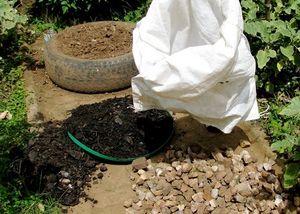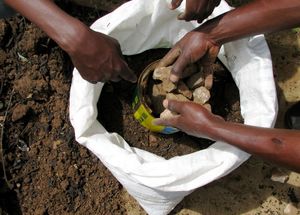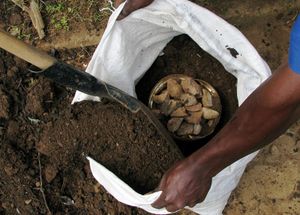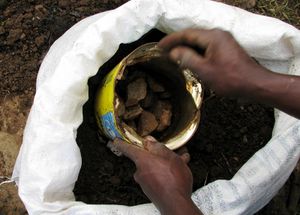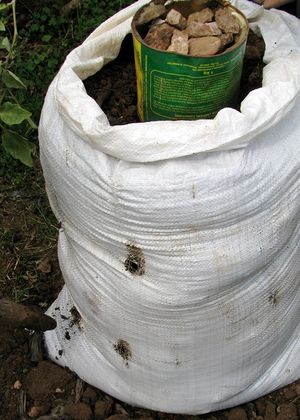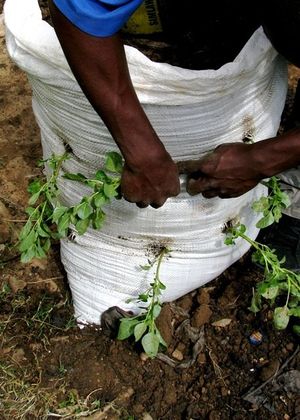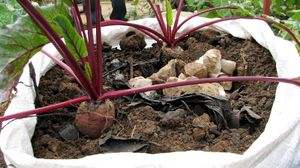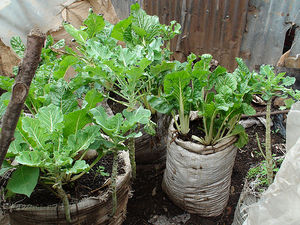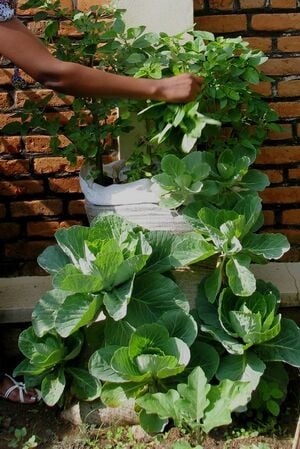
Bag/Sack gardens, also known as "vertical farms or gardens", are tall sacks filled with soil from which plant life grows. This concept for a small, portable garden is good for areas where the gardener may have to continually relocate, as well as for areas where there is little or no healthy soil (as the soil in the bag is contained). Due to their vertical nature, sack gardens are also fairly efficient in terms of using water.
Most of the initiatives and projects concerning sack gardens have been or are being conducted in the slums of Nairobi, Kenya, where the lack of appropriate farm land combined with the very low incomes and employment rates of families and individuals, as well as natural disasters such as landslides, result in very poor food security.
Several initiatives aimed at providing and training in the use of these sack gardens have reported high levels of success in terms of improving nutrition, food security, and income.
One has to note that sack gardens, although suitable for areas with traditional gardening challenges, can hardly compete with conventional kitchen gardens when they are feasible.
The term "sack garden" is sometimes also used to describe horizontal bag gardens, which are simply bags laid on one side with their other side cut open, so that the bag functions like a pot or trough.
Opportunities for applying sack gardens[edit | edit source]
The main advantages of sack gardens are their portability, low size, low cost, efficiency, productivity, and contributions to food security. These traits make them ideal in situations such as:
- Where investing in a traditional garden is too risky due to fear of expropriation or where individuals have no legal right to their land. By having a garden in a sack that one can move and put wherever they want, it becomes a more stable investment.
- Where population density and scarcity of arable prevent traditional gardening.
- Where contaminated soil is present.
- Where there is a high chance of natural disasters such as floods or mudslides.
- Where there is not enough ground-level sunlight to grow vegetables.
- Where drought is common or water very limited.
- Where there is a food crisis. Small scale homestead vegetable growing can greatly alleviate pressure from relief efforts.
- Where there are community development initiatives and programs aiming to address community vulnerabilities.
- To complement school garden initiatives with non-traditional urban gardening techniques.
- Where there is a little adult labour available. That is, child and female headed households, elderly headed households, households with chronically ill adults. Sack gardens are advantageous here due to their low physical requirements (they do not require ploughing or weeding, and the only heavy lifting involved is in moving the sack garden should the need arise).
- Where unemployment rates are high and the selling of even a small amount of plant life and seeds can improve household incomes.
The disadvantages of sack gardens[edit | edit source]
- Requires a sack.
- Requires disposal of the sack (which is made of oil-based plastic) after usage or when damaged.
- Excluding the flat top of the sack, plants cannot grow from seeds in a sack garden. This is because of the contained nature of the garden where a physical membrane (a sack) contains the soil, and the plants growing in the soil can only penetrate through specific predetermined holes. As a plant growing from a seed may choose not to grow through one of these holes and instead be stuck inside the bag where, without sun, it cannot grow. The only way to ensure that plants will is to transplant seedlings into said holes so that they already escape the sacks and are exposed to the outside environment.
How to make a bag garden[edit | edit source]
Necessary Materials.
- A woven burlap or plastic bag, such as a used food aid sack. A 1m3 bag will provide around 5m2 of accessible, farmable surface area.
- Enough soil or dirt mixed with compost or animal manure to fill the bag.
- Enough small stones to fill about a quarter to half of the bag.
- Seedlings of whatever plant life is desired. Common choices include tomatoes, onions, spinach, kale, spider plant, squash, amaranth, fodder, and African nightshade, with kale currently enjoying the most success.
- A knife or other device capable of cutting through the bag.
- Enough water to water the bag garden every day.
Although not necessary, a can or tin with no bottom and top is a helpful tool for assembling bag gardens. This guide will include the use of a hollow can to demonstrate its usefulness.
The total cost of the described bag garden, assuming the bag was discarded from a food aid sack, the fertilizer was collected from local wildlife or population refuse, is the initial price of the seeds or seedlings (from which further seeds and seedlings can then be grown) and the continual price of the necessary water.
Create the Base. Fill the bottom of the bag or sack with soil. Place the hollow can in the middle of the soil and then fill it with rocks – this is used as the watering system for the bag garden. Water is poured over the rocks and it slowly filters through the stones, gradually watering the vegetables without flooding them.
Recycling. Bag gardens can be used to grow plants during one growing season. After the plants die, the dead plants and roots should be taken out of the dirt. Once the growing season is over, the bag should be emptied, with the stones and any dead roots taken out of the dirt. The bag garden can be made again for the next growing season using the same instructions and materials, though the old dirt should be mixed with new manure, compost, or fertilizer.
Video from Uganda about making a Bag garden (intended for UK school use.)
Current and previous programs relating to sack gardens[edit | edit source]
NGO Solidarites' "Sack Garden" Project in the largest slums of Kenya[edit | edit source]
The French relief and reconstruction NGO Solidarites implemented a small scale agriculture pilot project in Kiambu and Kibera, two slums in Nairobi, Kenya. This project was funded by the French government involved planting vegetable seedlings in earth filled sacks placed on rooftops or doorsteps. Families were given one to three sacks filled with earth, and by the end of the pilot project 6000 families were producing tomatoes, onions, kales or spinach. A nursery was established in the slum to supply the initial necessary seedlings while a group was assembled to train the project's beneficiaries in the upkeep and assembly of sack gardens. Each supplied sack had a volume of 1 m3 and represented a farmable surface area of 5 m2. One of these sacks is able contain 50 seedlings of kales or spinach and 20 tomatoes plants. Vegetables are used directly and indirectly by the household to obtain food, access cash when needed, and educate children. On average, it was estimated that each household increased its weekly income by 5USD, a significant figure given the fact that in Kibera the rent of a house cost around 6USD a month.
"Mid Day Meal Schemes Programme" in India[edit | edit source]
In India, children attending government schools are provided with food as specified by Government regulations. That is, there is a provision of lunch free of cost to school-children on all working days with the key objectives of protecting children from classroom hunger, increasing school enrolment and attendance, improved socialisation among children belonging to all castes, addressing malnutrition, and social empowerment through provision of employment to women.[3] To meet this regulation, some schools have initiated vegetable production on their premises to add fresh vegetables to their mid day food. This helps add essential nutrients and vitamins to the food that is provided to the children. As there is little or no land available on many school premises, the sack garden technique is being investigated.
Small Scale Homestead Vegetable Initiatives in Gaza, Mozambique[edit | edit source]
Under FNPP programme (FAO-Netherlands Partnership Programme), the sack garden initiative was tested in Gaza for almost six months with tomatoes, lettuce, green pepper, spinach, cabbage, beets, parsley, turnip, onion, etc. The experiment was conducted through the FNPP office, and the rate of adoption was remarkable, particularly in the Northern Districts where drought and chronic malnutrition are a fact. The main conclusions from the initiative were that:
1) High and good quality production extended beyond the normal production season. 2) The incidence of plagues and weeds are almost none. 3) Less time was spent on different agricultural tasks (less upkeep required when compared to traditional gardening). 4) The water efficiency is quite impressive. 5) The overall production is very good. A general opinion was formed that about 10 bags might be enough to feed a family.
CL4 in South Africa[edit | edit source]
CL4 has organized sack gardens for households with family members ill with HIV/AIDS.
A Philippine initiative on food production[edit | edit source]
An initiative wherein used cans or trash plastic containers are utilized to grow plants/vegetables to supplement households' food intake.
WFP's "Multi-Storey Gardens" initiative in the two Kenyan refugee camps in Kakuma and Daadab[edit | edit source]
The Multi-storey gardens initiative was implemented to address the challenges created by the encampment policy for refugees in Kenya, which did not allow agricultural activities outside the camp. With limited space inside the camp, a scarcity of water, security concerns for women moving outside the camp, and the limitation of the WFP food basket with regard to fresh and micronutrient-rich food, sack gardens appeared a possible step towards improving conditions. Several thousand refugees participated in this programme.
ACF-USA Promotion of Micro Gardening[edit | edit source]
ACF-USA promoted micro gardening in small bed-, tyre-, and sack- form in the IDP camps in Northern Uganda due to problems with access to land caused by insecurity around the IDP camps. The production significantly contributes to the households' food supply and consumption, as well as to the households' income through sale in the IDP camps. The results of the programme show, that even in a small space there is a big potential for vegetable production, and therefore an enhancement of the dietary diversity and influence on the nutritional status of the population. These findings have helped promote micro gardening as a component of an integrated nutrition, water, and food security project in the North of Uganda.
- --
Organic sack gardening in Bangladesh== Introduced by Dr. Shaikh Tanveer Hossain http://www.new-ag.info/en/research/innovationItem.php?a=2982
Areas for further development[edit | edit source]
Although sack gardens have enjoyed much success and have improved the situations of many individuals and families, there is little documentation on the actual consumption versus yields of the gardens, or on what the total socio-economic impacts of sack garden initiatives are. In order to better understand, argue in favour for, and improve the sack garden technique, further research is required.
Several initiatives to further develop the technique include:
- Comparing equal surface areas of sack farming and traditional farming to better understand the amount of water savings under sack farming.
- Compare the amount of time labour required to harvest the same amount of produce for traditional and sack farming.
- Analyze yields from sacks compared to normal production.
- Clearly identify the number of sacks needed per household to sustain a family, taking into account production and consumption needs.
- Carry out a socio-economic analysis on the importance of production in sacks. That is, compare the costs of purchasing the necessary, dietary amount of vegetables with the costs of building and maintaining sack gardens capable of producing that same amount.
- Compare the costs associated with providing food relief over a period of time with the costs associated with providing the materials and training necessary for the food relief recipients to grow an equal amount of food in sack gardens.
References[edit | edit source]
- ↑ "Grow your own sack garden for health". Gardens for Health. 7 Jun. 2009. <http://gardensforhealth.blogspot.com/2009/06/grow-your-own-sack-garden-for-health.html>. 18 Apr. 2010.
- ↑ "CHBC Handbook". ADVANCED UNIT 15: EXPANDED ROLE OF THE COMMUNITY HEALTH WORKER. Pathfinder International. <http://web.archive.org/web/20071011172307/http://www.pathfind.org/site/DocServer/CHBC_HB_Unit_15_-_Exp_Role.pdf?docID=7983>, 18 Apr. 2010.
- ↑ "Education - Innovative and Path Breaking Initiatives/Projects." Mid-Day Meal Scheme. 4 Jul. 2010. National Informatics Centre, Government of India.. <http://india.gov.in/sectors/education/mid_day_meal.php>, 18 Apr. 2010.
- India
- Kenya
- South Africa
- SDG02 Zero hunger
- SDG06 Clean water and sanitation
- SDG10 Reduced inequalities
- SDG11 Sustainable cities and communities
- SDG12 Responsible consumption and production
- 2008
- Agriculture
- Food
- Gardening
- Soil
- How tos
- Production of supplemental crops
- Food and agriculture
- Food production
- Urban agriculture
- Nutrition
- Food security
